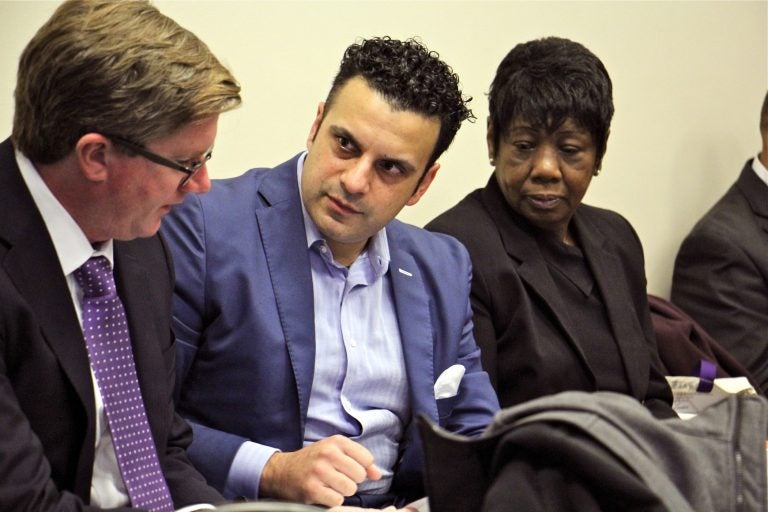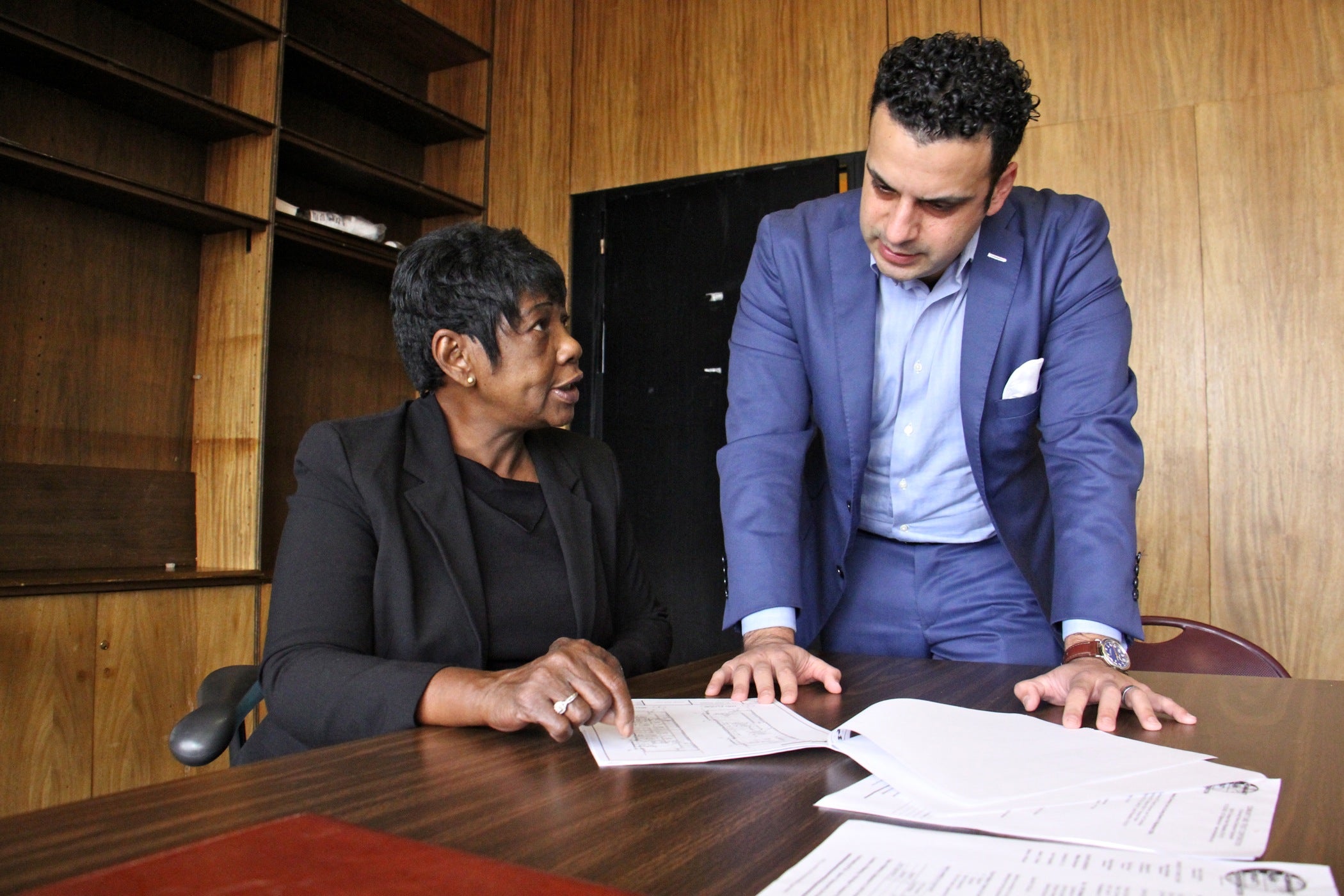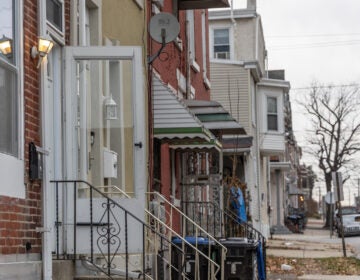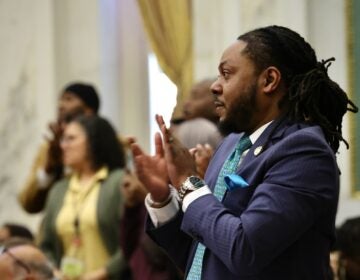What happens when your real estate gets remapped
Developers shift strategy after remapping and adapt their business models to develop more single-family homes for sale, instead of multi-family units for rent.

Developer Rahil Raza and Vivian VanStory consult with attorney Paul J. Toner during a Philadelphia zoning board meeting. (Emma Lee/WHYY)
This article originally appeared on PlanPhilly.
—
Rahil Raza was dead tired when he woke up on the chilly November morning of his appearance before Philadelphia’s Zoning Board of Adjustments.
There was a lot riding on the ZBA hearing and the real estate developer hadn’t been able to sleep the prior night. For a family-owned operation like Raza’s, any delay or setback in getting the city approvals needed to build can be devastating.
On that brisk late fall day, Raza was seeking approval to build a three-unit apartment building and an office topped by two apartments. He wanted to build both in a section of North Philadelphia where the rules regulating what can be built had recently been changed to discourage multi-family projects.
Raza wasn’t the only developer at the ZBA seeking a zoning variance to build apartments in a part of the city recently remapped in favor of single-family houses. By the end of the day, many of the cases heard would boil down to the same conflict — one that has erupted across the city as rowhome communities fight to keep out new development that they fear could change that character of these historically small-scale areas.
The fight has played out in ZBA hearings and City Hall meetings as City Council uses its power over zoning decisions to keep unwanted units out of rowhouse areas, even as demand for housing in these same neighborhood rises. Plans for new condos can inspire lawsuits, political battles, and plenty of angry calls to a district Council person about transient renters and looming parking crises.
These are fights that can look bloodless and technical from the outside, but for people like Raza, the people who he hopes to rent to and their neighbors, the stakes are high and very personal.
Last year, Council President Darrell Clarke passed the bill that downzoned the corner of North Philly where Raza owned 40 properties. Suddenly, the developer’s plans were no longer legal under city code.
Business ground to a halt as he struggled to formulate a new strategy. Raza ended up having to lay off ten of his employees.
“It was the worst feeling in the world,” recalled Raza.
The economic cost goes beyond the developer. Rezonings change property value for homeowners; they affect rents and rental options. Philadelphia’s run of downsizings makes it an outlier among U.S. cities. Today, governments are more often than not taking steps to increase the density of urban areas, not limit it.
For developers like Raza, and many housing experts, these policies highlight a tension between a desire from homeowners and the politicians who represent them to see neighborhoods dominated by single-family homes and a demand for smaller rental housing units that can plausibly retain a degree of affordability in areas close to Center City.
“I’m just a little surprised to hear about it because I can’t recently think of a city that’s been downzoning its urban neighborhoods,” said Daniel Parolek, a California architect who champions the concept of “missing middle” housing. “In higher-pressure areas that are experiencing increasing real estate values, neighborhoods have historically adapted by having flats on each floor. That’s a healthy evolution to allow.”
Remapping growth
Before he ever imagined a sleepless night tossing and turning over a trip to the zoning board, Raza was an aspiring pharmacist. But when he graduated from Temple University School of Pharmacy in 2009, the economy was still sunk under the weight of recession. Raza saw an opportunity to invest in real estate. With support from his family, Raza and his brother started their real estate business the fall after his graduation from pharmacy school. They got their start in South Philadelphia, to the west of Broad Street, but decided to shift focus northward because of the increasingly acrimonious relationship between the real estate industry and neighborhood groups in the Point Breeze neighborhood.
In 2011, Raza and his wife moved to Francisville, and he realized the development potential surrounding him. But as a real estate boom engulfed that area, he set his sights to the north, to the area between Broad Street, Ridge Avenue, Girard Avenue, and the expanding influence of Temple University around Jefferson Street.
Like many other rowhouse areas in the city, this part of North Philadelphia became zoned for multi-family development in the 1950s when planners expected the population to keep growing beyond 2 million. Instead, the city lost almost 500,000 residents. The census tract where Raza is building lost 70 percent of its population between 1960 and 2010. Over the last eight years, that number has edged up by a few hundred residents and there are plenty of indications that the population growth will continue.
Driving around the neighborhood, Raza points out the homes he’s built on vacant lots. There are the sites where he demolished four old buildings to build new and a historic townhouse on Master Street that he is restoring. The lion’s share of the 128 units of housing he’s built over the last nine years are within this slowly changing neighborhood and he aspires to become a bigger presence there. He sees himself in the mold of Ken Weinstein, a Germantown-based developer who values historic preservation and tends to focus on parts of the city that are not seeing a rush of reinvestment. Like Weinstein, he sees a need for quality affordable housing in these areas.
“Many … lots are so large and building a 5,000 square foot single family home is not possible, it’s just not my market,” Raza said. “Our model is to provide middle-income apartments for middle-income people and we’ve done that by building [smaller] multi-family instead of single-family housing.”
But Raza’s interest in North Philadelphia has coincided with city’s zoning code reform and the subsequent drive to remap the city for the first time in over half a century. That meant getting rid of a lot of old industrial zoning and also inking the downzonings that changed many neighborhood zones from RM-1, which allows multi-family apartments in rowhouse blocks, to RSA-5, which just allows single family.
“When I first heard about it [the rezoning bill], those was probably the worst three days of my life,” said Raza. “I had 40 lots in that area and overnight I found that 75 percent of them were going to be worth nothing.”
In the 18 months that followed the remapping, Raza cycled through a staggering array of emotional responses to this sudden change in fortune. But in the end, he decided that the Council President’s motivations were understandable.
“Before we had to manage decline, now we are in a position to manage growth,” Clarke told PlanPhilly after the bill passed. “If you look at that neighborhood, its history, that was a very stable single [family] residential area. Now it’s morphing significantly and a lot of the residents are uncomfortable with that.”
Raza reasoned that Clarke was trying to bend one of the principal tools at his disposal, zoning, to protect what he saw as the interests of his low-income and working-class constituents who did not want sharply increasing real estate taxes or a flood of apartments in their neighborhoods.
“I thought, well, he [Clarke] knows what he’s doing,” said Raza, who lived in Francisville before saving enough money to buy a house in the Delaware County suburb of Broomall. He chose Broomall so he could send his children to public schools there. But now with a small child and a second kid on the way, the couple hopes to buy a modest-size house in Chestnut Hill in the coming years, to cut down on the commute.
Council President Clarke does not have a relationship with Raza, but his press representative, Jane Roh, says that the office’s point-of-contact staffer is much blunter about the developer’s interests. “He [Raza] supports more units so he can make more money on the back end,” she wrote in an email to PlanPhilly.
Whatever his motivations, Raza shifted his strategy after the remapping. In many cases, he’s adapted his business model to develop more single-family homes for sale, instead of multi-family units for rent.
At a property he owns on Ingersoll Street, for example, he halved the number of units he planned to build and focused instead on 10 single-family homes. For a two-bedroom unit in the area, Raza says his rents start at $1,330 a month and while 3-bedrooms start at $1,950. He puts houses on the market at $350,000, if not higher.
Ken Steif, an urban planning professor at the University of Pennsylvania, says that Raza is not the only developer responding to the remappings by pivoting to a single-family model.
For larger developers with deeper pockets and tighter political connections, it is easier to navigate the city’s internecine bureaucratic and government networks. An inconvenient remapping becomes easier to handle. But there aren’t that many big developers, and for the smaller players, navigating local government is a far greater challenge.
Steif says that the end result may well be fewer affordable options for people who want to live in redeveloping neighborhoods and don’t have the money to buy a home.
“By having apartments you will allow much more accessible housing stock which will keep the neighborhoods relatively diverse in the face of gentrification,” he said.
Aggravating the problem is a political dynamic that puts City Council members in a position to answer to the desires of homeowners in their district and avoid many of the Planning Commission’s upzoning proposals.
West Philadelphia Councilwoman Jannie Blackwell, for instance, agreed to downzone Mantua but chose to keep density levels low on Lancaster Avenue, a commercial corridor that planners had targeted for upzoning.
Meanwhile, Clarke’s Francisville remapping increased the number of blocks zoned for single-family zoning neighborhood but skipped a recommended upzoning on Fairmount Avenue.
Likewise, a remapping recently introduced by Kenyatta Johnson scraps a lot of multi-family zoning in Point Breeze and won’t upzone the industrial parcels on Washington Avenue.

With help from a neighbor, a win
Amid rising tensions between homeowners and developers, Vivian Vanstory, founder and president of the Community Land Trust Corporation, has become an unlikely ally for Raza.
A homeowner herself, Vanstory is largely in favor of Clarke’s 2017 remapping and supportive of the changes the neighborhood has since over the last two decades of growth.
“Over 20 years it has evolved now into a good life to live, but before it had decayed and the quality of life was deteriorating from public housing and the lack of input from the city,” said Vanstory, who’s group controls 13,000 square feet of land in the neighborhood and serves as the Registered Community Group that fields zoning meetings.
But she also appreciates Raza, who she says is one of the only developers who listens to community concerns, rapidly cleans up his construction debris, and doesn’t allow his workers to park their trucks on the sidewalk. She says that he has hired unemployed young men in the neighborhood to work as unskilled laborers on his sites, even training a couple to do more advanced and better-paid work. Raza also contributes $1,500 a year, by his estimation, to support the Land Trust’s volunteer activities in the neighborhood.
Vanstory attended both of Raza’s zoning board hearings, spending much of her day at 1515 Arch in order to support his variance requests. She says that the community has opposed some of his efforts to build beyond single-family zoning, if they feel the lot is too small or if the block is largely comprised of homeowners.
But in today’s two ZBA cases the lots are larger, too large for a single family house that she thinks a reasonable person could afford. In the case of Raza’s office building with apartments above, he’s signed an agreement with the community that will prevent anyone using it for any other commercial use if he vacates the premises. Vanstory opposes commercial uses in the midst of residential areas because she says they tend to result in “vagrants” hanging around the shops.
“Rahil is a unique developer because he has integrity,” said Vanstory. “He reaches out to the neighborhood. He hired people who were standing on the corner doing things that they shouldn’t do. Now they are working. And that’s why I’m here today to help him with those variances.”
With Vanstory’s backing, and without opposition from anyone else, Raza secured both variances after spending a full day waiting at the ZBA on that cold November day. Council President Clarke did not send a staffer to oppose the variance, as the developer feared, and the Planning Commission representative did not oppose the request either.
Other property owners did not fare so well. Many of the other cases before the zoning board, where developers sought to build beyond recently mapped single-family zoning, saw their ambitions stunted.
A request for permission to build a triplex got the developer a variance for a smaller duplex instead. In one case, where a property owner talked back to the board, his request was denied altogether. In another case where a neighbor in transit-accessible West Philly’s Cedar Park said that her neighborhood is “inundated with density,” the board pushed off the decision for several months.
But for Raza, at least, the day ended well. He can move forward on the two projects, which represent almost half the units he currently has in his pipeline.
And with the near future assured, Raza and his wife will head out on their first vacation in two years, to a setting as different from the fluorescent lights and crowded confines of the zoning board as they can find. They spent the Thanksgiving holiday in the Bahamas.
WHYY is your source for fact-based, in-depth journalism and information. As a nonprofit organization, we rely on financial support from readers like you. Please give today.







